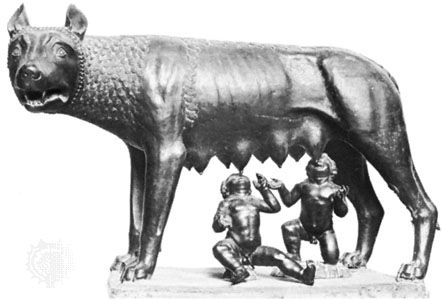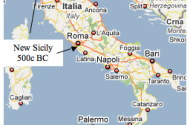“Sicilian Lights on Roman Origins”
“Sicilian Lights on Roman Origins”
(February 9, 2008)
Romulus and Remus
Romulus and Remus were Sicilians?
“Sicilian Lights on Roman Origins”
According to Arnold J. Toynbee, renowned historian and classical scholar, “the origin of Rome is open to question.” In an essay, “Sicilian Lights on Roman Origins”, he explores, “the possibility that the Romans were descended from Sicilian immigrants” (see: “A Study of History” vol. 8 pp. 704-708). I would emphasize Toynbee’s word POSSIBILITY. He does not claim to ‘prove’ that Sicilians originally settled Rome. Rather, he is positing, what I would call, a ‘Sicilian immigration theory’ to explain know facts (linguistic, geographic and ancient references) of the period.
He begins the essay with a description of a “linguistic map” of Italy in the first half of first millennium BC prior to when there is a clear and unequivocal existence of the Roman city-state in the historic record. According to this linguistic map, “there were various language groups present in Italy and Sicily during this period. Central Italy was largely populated by Umbrain and Oscan speaking people; with the noteworthy and perplexing exception of a Latin speaking enclave in the Tiber River basin.
The problem for the historian is how to explain, in Toynbee’s words: “the Latin enclave in an elsewhere Umbrian and Oscan speaking people in Central Italy...”, at the Southwest edge of Etruria and the future site of Rome.
* Linguistic facts indicate a possible solution to the problem:
At that time, three geographic groups of people spoke the Latin language:
1. “Sicel natives of Sicily”
2. “Ligurians in the North-Western Appennines”
3. “Latins and Falisci in the lower basin of the River Tiber”
* Common place-names in Riviera and Sicily
Toynbee: “We may find a clue to the puzzle [of the Tiber Latin enclave] if we turn our eyes for a moment to a point just beyond the opposite north-west extremity of Etruria near the mouth of the River Arno.” (Note: Etruria was essentially bounded on the Southwest by the Tiber River and on the Northwest by the Arno River and there are Latin speaking people on each of the boundary rivers.)
On the present day Italian Riviera are found four place-names that are identical to four places in Sicily. Toynbee: “At the eastern end of the Italian Riviera, we find four place-names – not of Roman mintage...identical with the principal place-names in the Elymian country in the north-western corner of Sicily.”
Specifically the common place-names are:
1a ‘Eryx’ a port on the Gulf of Spezia (modern city of Lerici)
1b ‘Eryx’ a mountain in NW Sicily (modern mountain of San Giuliano)
2a ‘Portus Veneris’ (modern Portovenere) on the Spezia Gulf dedicated to the same goddess know as Aphrodite (note: Venus is Aphrodite with different name)
2b ‘Temple of Aphrodite’ on the side of the Sicilian Mountain Eryx
3a ‘Segesta’ a town on Gulf of Genoa (modern Sestri Levante)
3b ‘Segesta’ city-state in NW Sicily
4a ‘Entella’ town on Gulf of Genoa (modern river with same name)
4b ‘Entella’ town in W. Sicily
In sum, the established historic facts are: (1) in pre-Roman times, people in W. Sicily and on the Gulf of Genoa spoke the Latin language and (2) there were four identical place-names in W. Sicily and on the Gulf of Genoa; suggesting that Latin speaking people from Sicily emigrated to the Riviera.
Toynbee: “the probability that the group of names in [the Riviera] was derived from the group in Sicily is indicated by the fact that in [the Riviera], as in Sicily the mountain-name appears in the Graecized form ‘Eryx’ and not in a Ligurian equivalent... ‘verruca’ (‘peak’), which we should expect to find surviving here if the name had originated in Liguria and had been carried thence to Sicily.”
Thus, the historian has made a strong linguistic case that Sicilians emigrated to the Italian mainland as far north as the present day Italian Rivera. This opens up the possibility that they also emigrateded to the Tiber River basin.
* Rome
There is no direct linguistic evidence of the type connecting Sicily with the Riviera that would connect Sicily with the Tiber Latins. However, there is circumstantial geographic evidence and ancient literary references that point to a Sicilian connection.
* Geographic Evidence suggesting Sicilian connections to pre-Roman Tiber Latins
Both the Rivieria and theTiber Latins established settlements, which gave them near identical and excellent defensive positions against Etrurian encroachments. Toynbee: “The Elymian settlers along the Eastern Riviera had chosen a location [north of the Arno River - the north western border of Etruria] where they could count on a ‘natural frontier’ to safeguard them against Etruscan encroachments; for...the Arno was a pestilential swamp, which Hannibal’s army found almost as difficult to traverse as the Alps...”
Similarly, Tiber Latins were located at a site that provided the same type of geographic defensive characteristics. Toynbee: “The Etruscan’s Latin neighbors [to the south, on the Tiber] enjoyed the benefit of a protective river-barrier which [in later centuries] enabled the Romans to repulse the Etruscan war-lord Lars Porsenna’s...”
* More regarding geography:
Toynbee: “A scrutiny of the map of Latium confirms the impression that this Tiberine enclave of a Latin-speaking population was...a ‘bridgehead’ established by invaders from overseas who had made a landing ‘vi et armis’ on the beaches just south-east of Ostia...[moving to] an area covered by a number of natural frontiers: the river-line constituted by the courses of the Lower Tiber and its tributary the Anio, the south-western spurs of the Sabine Mountains, and the natural system of fortifications provided by the rampart-like slopes of the craters-within-craters know as the Alban Hills. The fortresses built by the Latin interlopers to protect this perimeter would have been Rome, Tibur, Praensete and Alba Longa.”
The historian summarizes his argument based on an analogy that the Tiber Latins were not indigenous rather settlers based on geographic evidence.
Toynbee: “On the analogy of the Elymian settlements along the Riviera, is it too rash a conjecture to guess that the cluster of Latin-speaking communities adjoining the lower course of the Tiber... were colonists from Sicily who had succeeded in thrusting themselves into a promising site at the farthest south-eastern outpost of Etruria …?”
If the evidence for the argument that the Latins on the Tiber were Sicilian immigrants were only the circumstantial geographic analogy with the Latin Ligurian settlements, then the case would be weak. However, the geographic analogy is buttressed by compelling factual ancient literary evidence.
* Ancient Literary Evidence suggesting Sicilian origin of Rome
There are three significant ancient references suggesting the Sicilian origin of Rome.
Pliny and Virgil
Toynbee: “Siculi are named by Pliny in a list of early peoples of Latium...[also]
Sicani are thrice enumerated by Virgil among the people already established in Latium before the advent of Aeneas [mythological founder of Rome]”
Heracleides Ponticus
Toynbee: “The earliest mention of Rome in extant literature is a notice, in a surviving fragment of a lost work from the hand of Plato’s student, Heracleides Ponticus, in which this Latin commonwealth is described as ‘a Hellenic city’... [Further,] Rome earned this compliment by spreading the political elements of Hellenic culture...” Hellenic implies the Greek culture of Sicily.
Although Toynbee only makes a passing reference to the Heracleides characterization of Rome as “a Hellenic city”, to my mind, it seems highly significant and warrants greater emphasis.
Heracleides Ponticus was writing in the first half of the fourth century BC. How did it come to be that a Latin city not under Greek colonial control or direct border contact with Greek colonies (the Oscan lands separated the Tiber Latins from Magna Grecia in the south) came to be characterized as Hellenic? The Sicilian immigration theory provides an explanation: i.e. indigenous Sicilians adopted Greek culture in Sicily and carried it to immigration settlements on the Tiber and created Rome a “Hellenic city.”
* Summary
Toynbee is not claiming to have proved that Rome was originally a Sicilian settlement. He has suggested, in his words: “the possibility that the Romans may in fact have been descended from [Sicilian] immigrants”. To my mind he is much too modest. In the parlance of science, he has posited a very robust explanatory theory. The measure of robustness is the number of known facts the theory can account for or explain. The more facts explained, the more plausible the theory.
The facts explained by the ‘Sicilian immigration theory’ are as follows:
1. 1. The identical place-names on the Riveria and in Sicily
2. 2. Similar geographic characteristics of the Latin Riveria and Tiber settlements
3. 3. Ancient references to Sicilians and the origins of Rome
4. 4. Hellenic characteristics of original Rome
Finally, on a subjective note, what a delicious irony: the quintessential cultural centers of northern Italian denigrators of Sicily were originally Sicilian colonies!
......
For a more detail discussion of possible Sicilian colony on the Italian Riviera circa 500 B.C. see linked article “Science, Irony and Italian History - a “Southern Question” twist! in the Related Articles box at the top.
......
For a more detail discussion of possible Sicilian colony on the Italian Riviera circa 500 B.C. see linked article “Science, Irony and Italian History - a “Southern Question” twist! in the Related Articles box at the top.
DISCLAIMER: Posts published in i-Italy are intended to stimulate a debate in the Italian and Italian-American Community and sometimes deal with controversial issues. The Editors are not responsible for, nor necessarily in agreement with the views presented by individual contributors.
© ALL RIGHTS RESERVED - RIPRODUZIONE VIETATA.This work may not be reproduced, in whole or in part, without prior written permission.
Questo lavoro non può essere riprodotto, in tutto o in parte, senza permesso scritto.
Add a comment






